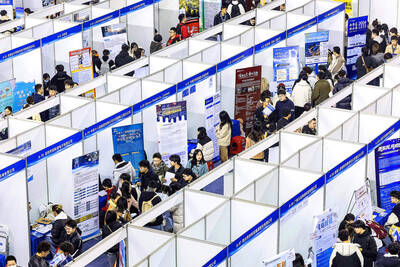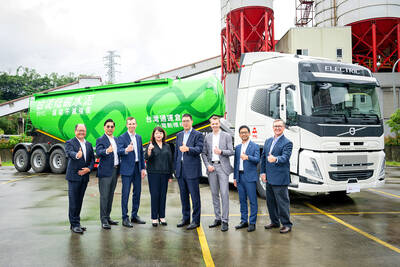Zoox Inc, the self-driving start-up owned by Amazon.com Inc, unveiled a fully autonomous electric vehicle with no steering wheel that can drive day and night on a single charge.
The vehicle, which Zoox describes as a driverless carriage or robotaxi, can carry as many as four passengers. With a motor at each end, it travels in either direction and maxes out at 120kph.
Two battery packs, one under each row of seats, generate enough juice for 16 hours of run time before recharging, the company said.

Photo: AFP
To commercialize the technology, Zoox plans to launch an app-based ride-hailing service in cities like San Francisco and Las Vegas.
“This is really about reimagining transportation,” Zoox CEO Aicha Evans said in an interview with Bloomberg Television. “Not only do we have the capital required, we have the long-term vision.”
The company also plans to launch ride-hailing services in other countries, Evans said.
Executives did not say how much rides would cost, but that they would be “affordable” and competitive with services operated by Uber Technologies Inc and Lyft Inc. Nor did they say when the service would launch, but confirmed it would not happen next year.
In a video released yesterday, Evans used Zoox’s app to hail the vehicle outside San Francisco’s Fairmont hotel and took a spin around the block.
Acquired by Amazon in June for an undisclosed sum, Zoox is one of several companies racing to put fully autonomous vehicles on the road, an effort that is taking longer than anticipated. Most are testing retrofitted conventional vehicles on public roads, and few are commercially deployed.
In October, Alphabet Inc’s self-driving unit Waymo started a fully driverless taxi service in suburban Phoenix, Arizona. General Motors Co-backed Cruise LLC is also testing autonomous vehicles — without safety drivers — in San Francisco, using a fleet of electric vehicles based on the Chevy Bolt.
Despite being years from deployment, several of Zoox’s quirky-looking mint-green vehicles are already being built at a facility in Fremont, California.
The factory has the capacity to eventually produce 10,000 to 15,000 units annually, executives said.
Suppliers send the major components — the drive unit, body, battery pack and so on — pre-assembled, and Zoox does final assembly in stages, a process it likens to building a Lego set. Executives declined to reveal the battery supplier.
The unveiling of a production vehicle marks a significant step for a company that has been working on an autonomous passenger vehicle since its founding in 2014.
At times Zoox was “ridiculed” for what it was trying to do, chief technology officer Jesse Levinson told Bloomberg TV.
“Unlike many of the concept cars other companies have shown in the last several years this vehicle has passed all the FMVSS crash tests,” Levinson said, referring to the Federal Motor Vehicle Safety Standards required by US regulators.
Zoox is not the first to unveil a fully autonomous passenger vehicle, as the Cruise showed off a battery-powered shuttle in January.
Called the Origin, it also does away with many of the controls present in conventional vehicles: pedals, rearview mirrors, steering wheel. Cruise plans to commercialize the Origin through a ride-sharing service and says it is cheaper to run than a conventional vehicle.
Zoox’s vehicle is similar, but smaller.
On each corner a “sensor pod” houses a spinning laser sensor and other lidars, as well as cameras to help it navigate. A pair of front-facing cameras sit atop of the vehicle, with other less-visible sensors mounted on the sides.
A pair of front-facing cameras sit atop of the vehicle, with other less-visible sensors mounted on the sides.
The vehicle’s safety features include airbags that form a cocoon around each passenger in the event of a crash, which Zoox says is unlikely given its confidence in the technology.
The company can manually operate the vehicles remotely and communicate with passengers in real time.
For those worried about privacy, Zoox says passengers would have the option to blur images captured by the onboard camera.

Stephen Garrett, a 27-year-old graduate student, always thought he would study in China, but first the country’s restrictive COVID-19 policies made it nearly impossible and now he has other concerns. The cost is one deterrent, but Garrett is more worried about restrictions on academic freedom and the personal risk of being stranded in China. He is not alone. Only about 700 American students are studying at Chinese universities, down from a peak of nearly 25,000 a decade ago, while there are nearly 300,000 Chinese students at US schools. Some young Americans are discouraged from investing their time in China by what they see

Taiwan Transport and Storage Corp (TTS, 台灣通運倉儲) yesterday unveiled its first electric tractor unit — manufactured by Volvo Trucks — in a ceremony in Taipei, and said the unit would soon be used to transport cement produced by Taiwan Cement Corp (TCC, 台灣水泥). Both TTS and TCC belong to TCC International Holdings Ltd (台泥國際集團). With the electric tractor unit, the Taipei-based cement firm would become the first in Taiwan to use electric vehicles to transport construction materials. TTS chairman Koo Kung-yi (辜公怡), Volvo Trucks vice president of sales and marketing Johan Selven, TCC president Roman Cheng (程耀輝) and Taikoo Motors Group

MAJOR DROP: CEO Tim Cook, who is visiting Hanoi, pledged the firm was committed to Vietnam after its smartphone shipments declined 9.6% annually in the first quarter Apple Inc yesterday said it would increase spending on suppliers in Vietnam, a key production hub, as CEO Tim Cook arrived in the country for a two-day visit. The iPhone maker announced the news in a statement on its Web site, but gave no details of how much it would spend or where the money would go. Cook is expected to meet programmers, content creators and students during his visit, online newspaper VnExpress reported. The visit comes as US President Joe Biden’s administration seeks to ramp up Vietnam’s role in the global tech supply chain to reduce the US’ dependence on China. Images on

New apartments in Taiwan’s major cities are getting smaller, while old apartments are increasingly occupied by older people, many of whom live alone, government data showed. The phenomenon has to do with sharpening unaffordable property prices and an aging population, property brokers said. Apartments with one bedroom that are two years old or older have gained a noticeable presence in the nation’s six special municipalities as well as Hsinchu county and city in the past five years, Evertrust Rehouse Co (永慶房產集團) found, citing data from the government’s real-price transaction platform. In Taipei, apartments with one bedroom accounted for 19 percent of deals last